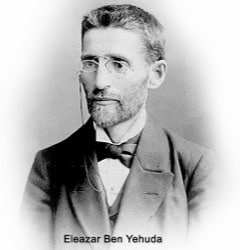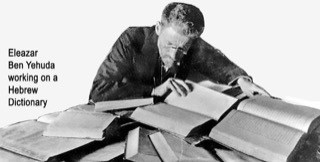John R Ecob D.D.
My determination is to gather the nations, that I may assemble the kingdoms, to pour upon them mine indignation, even all my fierce anger: for all the earth shall be devoured with the fire of my jealousy. For then will I turn to the people a pure language, that they may all call upon the name of the LORD, to serve him with one consent (Zephaniah 3:8-9)
God has promised that Israel will speak a “pure language” in the last days when they turn to the Lord and we might ask what language will that be?
If we trace the language spoken by the Jews throughout Scripture we will find that Hebrew was always spoken by Israel and can be traced back even to Adam! The language is pure because God spoke it.
When Jacob was returning from Haran about 1900BC he was pursued by his father-in-law Laban, who accused him of stealing his terraphim (family images). The dispute was settled with a covenant and a pillar of stones was built as witness to the covenant. Laban called it by an Aramaic name (Jegarsahadutha) but Jacob called it by a Hebrew name (Galeed); both names meant “heap of witness”.
So it is clear that the Patriarchs spoke Hebrew. Abraham was called “the Hebrew” (Genesis 14:13); the Egyptians called Joseph “an Hebrew” (Genesis 41:12) and his brethren came from the “land of the Hebrews” (Genesis 40:15) at the time of famine to get food. The “Hebrew mid-wives” about 1500BC would not kill the baby boys in Egypt (Exodus 1:15) and God called Himself “the LORD God of the Hebrews” (Exodus 9:13) when He sent Moses to Pharaoh.
Since the Patriarchs, Abraham, Isaac and Jacob were all Hebrews and all spoke Hebrew, and since Abraham came from Ur of the Chaldees with Terah his father, we can assume that Terah spoke Hebrew when he was in the land of Chaldea where Nimrod build the tower of Babel.
We know that Abram was born the year that Noah died and according to the Jewish Talmud, when Abram as a young man, smashed the idols of Terah, Nimrod ordered he be put to death so Abram fled to Shem for protection.
The father of the Hebrew race was Eber and Shem is referred to as the “father of all the children of Eber” (Genesis 10:21) which directly links Shem with the Hebrews who spoke Hebrew. Eber was the great-grandson of Shem.
Eber had a son named Peleg and it was “in his days the earth was divided” (Genesis 10:25). The division of the earth into areas allocated to nations took place when God confused the languages at the tower of Babel; God not only confused the world’s languages but also allocated geographic regions for each language group to occupy.
When God gave the “isles of the Gentiles” to the descendants of Javan, He did it, “every one after his tongue, after their families, in their nations” (Genesis 10:5).
Before the Tower of Babel was built “the whole earth was of one language, and of one speech” (Genesis 11:1) and if Shem was “the father of all the children of Eber” (the Hebrews) it is reasonable to suggest that Shem spoke Hebrew and that the land of Canaan was the allocated territory for the Godly line of Shem and God communicated this fact to Abram in Ur of the Chaldees when He told him to go “to a land that I will show thee” (Genesis 12:1). Thus Canaan became known as “the land of the Hebrews” (Genesis 40:15).
The construction of the Tower of Babel was an attempt to build and idolatrous place to worship the sun, moon, and stars. Nimrod intended to centralize the government of the world with one world religion just as Antichrist will do at the mid-point of the Tribulation. The words “may reach” in the KJV are in italics which means they are not in the original Hebrew; the tower was built “unto heaven” (Genesis 11:4).
God’s purpose in confusing the language of the people was to stop construction of the Tower and prevent its completion. The Godly line would not have participated in construction of the Tower and their language would not have been confused; they became God’s witness to all the nations through the centuries.
When God scattered the people according to their languages He placed the Hebrew race in the land of Canaan at the Geographic centre and cross-roads of the three great continents of Europe, Asia and Africa. Jerusalem was chosen as the place where God placed His name (Deuteronomy12:11).
The Hebrew language spoken by the Godly line of Shem, must therefore have been that “one language, and one speech” spoken before the confusion of tongues. Furthermore, since there was only one language before Babel, Hebrew must have been spoken by Noah and all the world back to Adam. In fact, it was the language spoke by God in Eden.

It is interesting to realize that Adam never learned a language. We begin as children and after twelve years of education should be proficient in speech but God planted the Hebrew language in the brain of Adam at the moment of creation. Not only so, but Adam wrote Hebrew for we have his book preserved in the Bible. When Moses wrote the Book of Genesis (“beginnings”) he incorporated the inspired writings, preserved through the centuries, by Adam (Genesis 5:1); Noah (Genesis 6:9); the sons of Noah (Genesis 10:1; 11:10); Terah (Genesis 11:27); Ishmael (Genesis 25:12); Isaac (Genesis 25:19); Esau (Genesis 36:1,9); Jacob and Joseph (Genesis 37:2).
When Noah went into the ark he took the “Book of the generations of Adam” with him, written in Hebrew. He also took “the generations of the heavens and the earth” (Genesis 2:4) which could only have been written by God or dictated by God in Hebrew!
The Hebrew language therefore predates all other languages and the claims by some that cuniform writing existed before Hebrew is false. Cuniform writing was one of the languages at the time of the Sumerian and Akkadian kingdoms several hundred years after the Flood in the time of Nimrod for it was Nimrod who built the city of Accad (Genesis 10:10).
The only pre-Flood writings we have are those preserved in the ark by Noah. All other writings preserved on clay tablets from the library at Nineveh containing 22,000 clay tablets and stone stelae established by Ashurbanipal the King of Assyria (669-627BC), and in other archaeological digs, are much later.
It is certain that Noah, who “walked with God”, would not have taken the writings of the ungodly with him into the ark.
When God told Zephaniah that, in the last days, He would “turn (restore) to the people a pure language” (Zephaniah 3:9) He was referring to the pure Hebrew language given by God to Adam in the Garden of Eden and spoken by the nation right down through the centuries. It was the common language of the Jews in Jesus’ day and only became corrupted after the Jews were scattered among the Gentiles.
In the time of Nehemiah, after the Babylonian captivity, the Jews were rebuked because they took Gentile wives and
their children spake half in the speech of Ashdod, and could not speak in the Jews’ language, but according to the language of each people(Nehemiah 13:24).
All of the Old Testament Scriptures were written in Hebrew except for portions in Daniel and Ezra which were in Aramaic. When Jesus was here the nation spoke Hebrew contrary to statements by some that He spoke Aramaic. When Pilate placed a public announcement on the cross he used letters of Greek, Latin and Hebrew. He did not use Aramaic. No doubt Jesus would have spoken several languages but as a child of 12 years He reasoned with the scholars in the Temple and that would have been in Hebrew. When He began His ministry in the synagogue at Nazareth He read from the prophet Isaiah in Hebrew.
When Paul was rescued by the Roman soldiers from a Jewish mob the captain asked, “Canst thou speak Greek?” But when he addressed the Jews from the castle steps he spoke to them “in the Hebrew tongue” (Acts 21:37,40).
Obviously the commonly spoken language in Israel was Hebrew.
Just because a few Aramaic words are found in Mark’s Gospel some “scholars” have wrongly assumed that Aramaic was the commonly spoken language in Jesus’ day. The writings of the Dead Sea scrolls are predominently Hebrew; the writing found on Masada in AD73 were all in Hebrew as were the letters of Bar Kochba who led a revolt against the Romans in AD135.
When God warned sinful Israel that He would speak to them in Gentile languages He said,
For with stammering lips and another tongue will he speak to this people (Isaiah 28:11).
So it is clear that in Isaiah’s day Gentile languages were considered “another tongue” and unintelligent (to Jews), like stammering, about 700BC. On the day of Pentecost, when Peter preached in Gentile languages, it was a cause for amazement and was a sign that God was turning from Israel to the Gentiles in the Church. Obviously the normal language at Jerusalem was Hebrew.
After 2,000 years of dispersion among the Gentiles after AD70, the Ashkenazic Jews (the Jews of Central and Eastern Europe and their descendants), spoke Yiddish (“Yid” means Jew) which uses a modified Hebrew alphabet. It is a mixture of Hebrew and German and other languages.
In the Sephardic Jewish culture (the culture of the Jews of Spain, Portugal, the Balkans, North Africa and the Middle East), they had their own international language known as Ladino or Judesmo, which is a hybrid of medieval Spanish and Hebrew.
Thus in the dispersion, after AD70 the pure language of Hebrew, preserved in the Hebrew Scriptures, was gradually replaced by Hebrew and Jewish words. Hebrew continued to be read but ceased to be used in daily communication.
When Eleazar Ben Yehuda arrived in Jerusalem in 1881 to begin work on a Hebrew Dictionary he was opposed by the Jewish establishment who wanted to continue using the mixed Yiddish language; they even stoned him on his way  to work but by 1922 when he died, the pure Hebrew language was accepted by Jews in Palestine. Before he died, a census in Palestine was taken and almost every Jew in the land put down on his form that Hebrew was his “mother tongue”!
to work but by 1922 when he died, the pure Hebrew language was accepted by Jews in Palestine. Before he died, a census in Palestine was taken and almost every Jew in the land put down on his form that Hebrew was his “mother tongue”!
In 1951 a dictionary of thirteen volumes, averaging 600 pages each had been printed.
God has said through Zephaniah, that in the last days He would restore the pure language to Israel so that they might
call upon the name of the LORD, to serve him with one consent (Zephaniah 3:8-9).
When Christ returns to establish His millennial kingdom, Israel will serve Him in perfect harmony using one language: Hebrew.
The dates surrounding the revival of Hebrew are significant. Ben Yehuda arrived in Israel in 1881 the same year that the Zionist movement began; when Jews began to return to the land. The Zionist Movement brought together the leaders of the Jews and culminated in the First Zionist Congress (1897) which assembled Jewish leaders at Basle in Swtzerland to discuss a national home for the Jews.
Prophetically this fulfilled Ezekiel’s prophecy of the dry bones, the first stage of which was a great “shaking, and the bones came together, bone to his bone”(Ezekiel 37:7). The persecution of Jews internationally at that time, drove the leaders of the Jews together as Ben Yehuda began to prepare his Hebrew Dictionaries. God’s timing was perfect!
By 1951 the Hebrew Dictionary was almost complete in 13 volumes!
Then in 1948 after WWII and the gas chambers of Europe, the nation of Israel was established. The bones were covered with sinews and skin but there was no breath in them (Ezekiel 37:8).
The world now awaits the final stage of Ezekiel’s prophecy that the breath of God will enter the carcasses and Israel will receive life from God; eternal life.
The conversion of Israel will occur in the first half of the Tribulation when Russia and Islam join to invade the land as described in Ezekiel 38 and 39. Only then will Israel serve the Lord with “one consent”. All the divisions caused by orthodox, ultra-orthodox, mystic kabbalists and conservative will be gone and in perfect unity the nation will be committed to service in Christ’s millennial Kingdom.
To speak Hebrew in the Millennial kingdom when Christ is reigning will be an honour for we read that “In that day shall five cities in the land of Egypt speak the language of Canaan, and swear to the LORD of hosts” (Isaiah 19:18). The restoration of the ancient Hebrew language is a vital sign of the last days.
